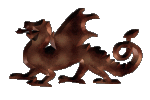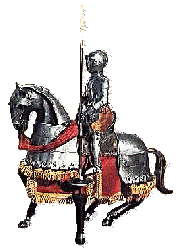 Battle
of Hasting
Battle
of Hasting
![]()

![]()
The date
is October 14, 1066.
On Telham
Hill, knights
on horseback
carry lances,
javelins
and brightly coloured
banners.
Wooden castles
on small
hills are built
called
mottes. These castles are
built
by digging out a
ditch
and piling up the
dirt.
If attacked, the people can
retreat
to them for safety.
One knight
stands
out among
the rest,
William,
Duke of Normandy.
Although
William is French,
he
leads the Norman army into battle,
claiming
he is the rightful King of England.
By
landing in Sussex , he is prepared
to fight
the Saxon army,
led by
Harold, King of England.
The Norman
army has skilled
archers
with bows and
arrows
leading the way. These
archers
can kill a man by firing an arrow
from
a distance of 100 meters or more.
Behind
the archers
are foot
soldiers with spears and axes.
The knights
on
horseback
follow the foot
soldiers.
These knights are
called
the calvary and can move much
faster
than foot soldiers.
They
are heavily armed
and wear
coats of mail,
split
at the bottom
to allow
for ease of
movement
while riding a horse.
The horses
are not protected
by armour,
so a knight
can be
brought down
by killing
his horse.
The knights
also wear
cone-shaped
helmets
to protect
their faces.
King Harold
has about
the same
number of men
as William,
but most of his
men are
exhausted by the time
they
set up camp near the
village
of Battle near Sussex.
There
are two main
types
of Saxon soldiers.
The house-carls
are a group
of about
3000 foot soldiers
that
make up the king's
bodyguard.
They fight with
with
long, heavy axes that
can split
a man in two
with
one blow. The house-carls
wear
hauberks for
protection.
Hauberks are
coats
of mail made
by sewing
wire rings together
and
are extremely heavy. These
soldiers
also carry kite shaped
shields
to protect them from
arrows,
stones, swords,
and other
objects hurled
at them.
The house-carls
are said
to be the finest
soldiers
in Europe.
The Saxon
soldiers begin
to tense
up as they see
this
enormous army heading
towards
them. No matter
how afraid,
they stand ready to
fight
the Normans and defend
King
Harold and England.
The Battle
of Hastings has begun.
William
makes the first attack and
is met
with strong
resistance.
As the fierce hand
to hand
combat weakens
the English,
William makes his
final
attack in the evening.
In less
than ten hours, the battle
is over.
The fields are covered
with
bodies of dead and wounded
soldiers
and horses. King Harold
and his
brothers have been killed.
William
Duke of Normandy
rides
as if he is already the new
King
of England. The English
Saxons
have lost and the
French
Normans have won.
The course
of history over the
next
300 years is changed.
Not only
is England a closer part
of Europe,
but the nobles of
England
speak French, not English
and spend
time on their
French
estates. It also changes
the way
the country is
ruled.
Under Saxon rule,
the earl
is often as
important
as the king, but
under
Norman rule, the king
is the
only one in control
and his
rule is law.
Today
the village where
the battle
of Hastings
took
place is called Battle.
The
town of Hastings
is approximately
six miles to the
south
east of the battlefield.
The battle
is later called Senlac,
meaning
a river of blood.
![]()
![]()




